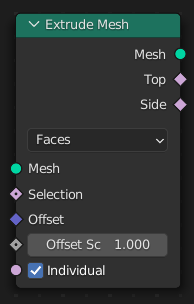挤出网格

The Extrude Mesh Node generates new vertices, edges, or faces, on selected geometry and transforms them based on an offset.
这些操作类似于 挤出工具 在网格编辑模式下,尽管有一些差异。最重要的是,该节点从未将挤压的背面保持在适当位置,它们总是被移除。属性传播规则也可以是不同的。
输入
- 网格
标准的几何体输入。
- 选择
Whether to extrude each element. True values mean elements will be extruded, false values mean elements will remain unchanged.
- 偏移量
The amount to translate the new geometry on each axis. The default value of the "Offset" input is the mesh's normals. To change the distance, the Scale input can be used. However, when an input is computed for this directly, the length of the input vectors is used.
Tip
Because the default input is the mesh's normals, they may need to be calculated just for this node. If the extrusion is only in one direction anyway, a potential performance improvement is to connect a 矢量节点 instead.
- 缩放
The factor used to scale elements or groups of elements.
- 各面 仅限面模式
Whether to extrude each face individually rather than extruding connected groups of faces together as regions. A quad side face will be generated on each side of every selected face.
属性
- 模式
- 顶点:
This mode is quite simple, it just attaches new edges and vertices to the selected vertices.
- 边:
Attach new quad faces to the selected edges. Vertices shared by the original selected vertices are also shared in the duplicated edges.
Note
Depending on the situation, the normals of the new faces may be arbitrary. If the selected edges only have one selected face, then the node can pick a consistent orientation for the new faces, but if there is more than one connected face, or no connected faces, the normals may have to be adjusted afterwards.
- 面:
根据 单个 布尔输入,单独挤出选定面或每个选定面的连续区域。
When the Individual input is false, the node will find regions of connected faces and generate new "side" faces on the boundaries of those regions. If the whole mesh is selected and it is already a Manifold shape, then result will just be that the whole mesh moves. Any vertices, edges or faces on the inside of the face regions are just moved, they are not duplicated.
输出
- 网格
标准的几何体输出。
- 顶
A boolean field output containing the top new top geometry. The domain depends on the selected mode. In Vertex mode, this is a selection of the new vertices. In Edge mode, this is a selection of the duplicated edges and in Face mode, it is a selection of the new faces.
- 侧面
A boolean field output containing the "side" of the new geometry. In Vertex mode, it selects the new edges, in Edge mode, the new faces, and in Face mode, the new side faces are selected, which are all of the new faces that aren't in the Top selection.
示例

Here, the selection outputs are used to set materials on certain faces of the mesh. A 随机值 node can be used to limit the extrusion to a random set of faces.
属性传播
属性将传输到具有特定规则的新元素。属性将永远不会更改生成的网格上的域。id 属性没有任何特殊处理。
通常,布尔属性用 "或" 传播,这意味着为其他类型混合的任何连接的 "true"值也将导致新值为 "true"。
以下章节描述:
顶点模式

在顶点模式下创建的新边缘使用所有连接边缘的平均值。
新的 顶点 复制了原始顶点的值
新的 边缘 具有任何连接的原始边缘的平均值。对于布尔属性,如果选择了任何连接的边缘,则选择边缘。
边模式

新的连接边缘(垂直黄色边缘)的属性传播。最终值是两个中间蓝色边缘的值的混合。不使用图像下方的较暗的栗色边缘。
新的 顶点 已从其原始顶点复制值。
垂直连接 边线 从任何连接的挤出边获取平均值。对于布尔值,如果选择了任何连接的挤出边,则会选中边。(传播规则如上图所示)
水平复制 边缘 已从其原始边缘复制值。
新的 面 获取连接到选定边缘的所有面平均值。对于布尔值,如果选择了任何连接的原始面,则选择面。
新的 面角 获取连接到选定边缘的所有面中相应角的平均值。对于布尔值,如果选择了其中一个角,则选择角。
面模式

新的连接边缘(垂直黄色边缘)的属性传播。最终值是两个中间蓝色边缘的值的混合。不使用来自未选择的面与挤出区域顶部之间较暗的栗色边缘的值。
新的 顶点 已从其原始顶点复制值。
垂直连接 边缘 从任何连接的挤出边缘获取平均值,不包括挤出区域的 "顶部" 边缘。对于布尔值,如果选择了任何这些连接的边缘,则会选择边缘。(传播规则如上图所示)
水平复制 边缘 已从其原始边缘复制值。
新的 面 已从相应的挤出面复制值。
新的 面拐角 已从相应的挤出面角复制值。
各面模式

新连接边缘的属性传播。每个边使用其挤出面上的两个相邻边的平均值。
新的 顶点 已从其原始顶点复制值。
垂直连接 边 获取每个挤出面上两个相邻边的平均值。对于布尔值,当选择挤出面上的至少一个邻项时,选择边。
水平复制 边缘 已从其原始边缘复制值。
新侧 面 已从其相应的选定面复制值。
新的 面转角 已从所选面部的相应角落复制值。